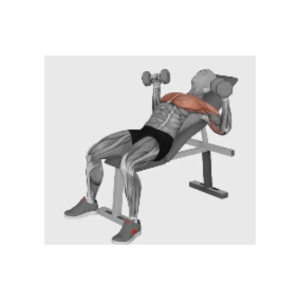Dumbbell incline bench press
The dumbbell incline bench press is a strength training exercise that targets the upper chest muscles, triceps, and shoulders. It is performed on an incline bench with a pair of dumbbells, lifting and lowering the weights to the chest and repeating for several repetitions.
This exercise effectively adds variety to your chest workout routine and builds upper body strength.
Main muscles used doing the dumbbell incline bench press
The main muscles used during the dumbbell incline bench press are the pectoralis major (upper chest), triceps, and deltoids (shoulders). Additionally, the secondary muscles worked include the biceps,lats, and triceps. By targeting these muscle groups, the dumbbell incline bench press helps to build overall upper body strength and improve posture.
Instructions on how to do the dumbbell incline bench press
Here are the steps to perform a dumbbell incline bench press:
- Set up an incline bench at a 45-degree angle and adjust the dumbbells to the appropriate weight.
- Lie on the bench with your feet flat on the floor and your back firmly pressed against the bench.
- Grab a dumbbell in each hand with a neutral grip (palms facing each other) and extend your arms straight up towards the ceiling.
- Lower the dumbbells slowly towards your chest, keeping your elbows tucked in close to your body.
- Once the dumbbells are just above your chest, pause for a moment and then press the weights back up to the starting position, keeping your arms straight and shoulders engaged.
- Repeat for the desired number of repetitions, then release the dumbbells back to the floor and carefully sit up.
It is important to use proper form and not let the weights drop too quickly, which could increase the risk of injury. Also, keep your breathing steady and consistent throughout the exercise.
Tips for doing the dumbbell incline bench press
Here are some tips for performing the dumbbell incline bench press effectively and safely:
- Warm up: Do a 5-10 minute warm-up and stretching routine before starting the exercise to prevent injury.
- Use a full range of motion: Lower the weights to your chest and press them back up until your arms are fully extended.
- Maintain proper form: Keep your back pressed against the bench, your elbows tucked in, and your shoulders engaged throughout the exercise.
- Control the weight: Do not let the weights drop too quickly or use momentum to complete repetitions.
- Focus on your chest: Keep the focus on your upper chest, rather than your triceps or shoulders.
- Gradually increase weight: Start with lighter weights and gradually increase the weight as you build strength and endurance.
- Vary your routine: Include the dumbbell incline bench press as part of a well-rounded workout routine, and vary the exercises you perform to target different muscle groups.
It is important to listen to your body and stop if you feel any pain or discomfort. Consulting with a personal trainer or fitness professional can also help ensure you use proper form and technique.
Benefits of doing the dumbbell incline bench press
The dumbbell incline bench press offers several benefits, including:
- Increased upper chest strength and definition: The incline bench position emphasizes the upper chest muscles more, helping to build strength and definition in this area.
- Improved posture: Strengthening the chest and upper back muscles can help improve posture and reduce the risk of back pain.
- Better overall upper body strength: The dumbbell incline bench press works several muscle groups, including the chest, triceps, shoulders, and biceps, helping to build overall upper body strength.
- Reduced risk of injury: By using dumbbells instead of a barbell, the dumbbell incline bench press can reduce the risk of injury to the shoulders and wrists, as it allows for a greater range of motion and more balanced muscle activation.
- Improved athletic performance: Building upper body strength can enhance athletic performance in sports that require upper body power and control.
Incorporating the dumbbell incline bench press into a well-rounded workout routine can help you achieve these benefits and improve your overall fitness. However, it is important to start with lighter weights and gradually increase the weight as you build strength and endurance.
For other chest exercises like dumbbell incline bench press, go to http://bptrainingcoaching.com/chest-exercises/.

